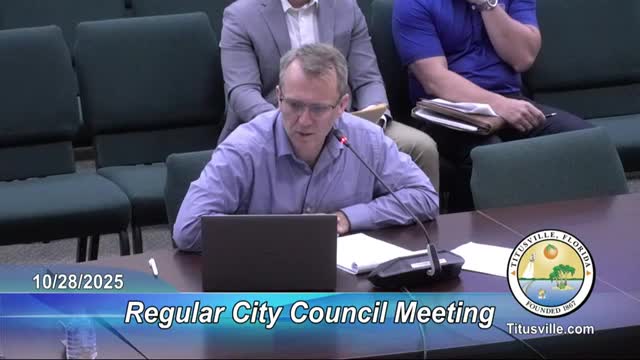Council transmits evaluation and appraisal review; plan updates address housing, waterfront, landscaping and septic‑to‑sewer items
October 29, 2025 | Titusville, Brevard County, Florida
This article was created by AI summarizing key points discussed. AI makes mistakes, so for full details and context, please refer to the video of the full meeting. Please report any errors so we can fix them. Report an error »

Consultants presented the required seven‑year Evaluation and Appraisal (E&A) review and associated proposed comprehensive plan changes at the Oct. 28 meeting. The E&A is a statutorily required review of the comprehensive plan and the consultant said the city’s current future land use map and adopted levels of service are projected to support about 6,000 additional residents by 2050 under the University of Florida medium projection used for the report.
Key changes included: removal of a coastal management policy now precluded by state law; updates to the public schools element regarding impact fee reporting; added septic‑to‑sewer language in the infrastructure element to address impaired waters; language to support accessory dwelling units in the housing element; expanded capital improvements language to enable mobility fee support and options to waive impact fees targeted specifically to low‑income affordability projects; and strengthened future land use language to protect the waterfront as a public realm and to promote native/Brevard‑native landscaping and canopy improvements.
Planning staff and consultants told council they incorporated public comments from prior outreach and the Planning & Zoning transmittal hearing on Oct. 8. Two changes were adopted after public comment: insertion of “Brevard native” into landscaping language and removal of a proposed conservation‑element policy that would have directed a wetland study; staff said removal does not preclude the council or TEC from pursuing wetlands review and that the TEC’s pending request for staff time to review future land use wetlands language is compatible with the transmittal.
Council members raised questions about sewer and water capacity in light of recent flooding. Consultants explained that water supply planning is a separate, more frequent process (updated every five years) that generally uses more aggressive population projections and that the city maintains a network of pressure monitors and planned enhancements. Council voted unanimously to transmit the E&A amendments to the state.
Ending: Staff said additional implementation steps (land‑development code updates, impact‑fee waivers and capital improvements programming) will follow separate code and budget actions.
Key changes included: removal of a coastal management policy now precluded by state law; updates to the public schools element regarding impact fee reporting; added septic‑to‑sewer language in the infrastructure element to address impaired waters; language to support accessory dwelling units in the housing element; expanded capital improvements language to enable mobility fee support and options to waive impact fees targeted specifically to low‑income affordability projects; and strengthened future land use language to protect the waterfront as a public realm and to promote native/Brevard‑native landscaping and canopy improvements.
Planning staff and consultants told council they incorporated public comments from prior outreach and the Planning & Zoning transmittal hearing on Oct. 8. Two changes were adopted after public comment: insertion of “Brevard native” into landscaping language and removal of a proposed conservation‑element policy that would have directed a wetland study; staff said removal does not preclude the council or TEC from pursuing wetlands review and that the TEC’s pending request for staff time to review future land use wetlands language is compatible with the transmittal.
Council members raised questions about sewer and water capacity in light of recent flooding. Consultants explained that water supply planning is a separate, more frequent process (updated every five years) that generally uses more aggressive population projections and that the city maintains a network of pressure monitors and planned enhancements. Council voted unanimously to transmit the E&A amendments to the state.
Ending: Staff said additional implementation steps (land‑development code updates, impact‑fee waivers and capital improvements programming) will follow separate code and budget actions.
Don't Miss a Word: See the Full Meeting!
Go beyond summaries. Unlock every video, transcript, and key insight with a Founder Membership.
✓
Get instant access to full meeting videos
✓
Search and clip any phrase from complete transcripts
✓
Receive AI-powered summaries & custom alerts
✓
Enjoy lifetime, unrestricted access to government data
30-day money-back guarantee
